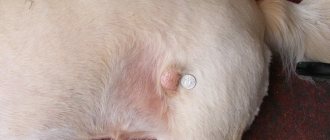Venereal sarcoma in dogs is a malignant neoplasm that affects the mucous membranes. A sick pet can infect other animals, so at the first signs of illness it is necessary to take protective measures. The sooner the disease is diagnosed, the easier it is to protect others and prevent the tumor from growing into neighboring tissues.
Causes of the disease and routes of infection
The causes of the disease in pets are uncontrolled mating and low immunity. Vensarcoma is sexually transmitted, so it is most often diagnosed in stray animals. Males get sick less often than females. Cases of their infection account for only 29%.
During mating, tumor cells are separated from the infected person and transferred to his partner. Once inside the new organism, they change the structure of its cells by shortening the chromosomes. Instead of the required 78, the patient has no more than 64.
In addition to sexual intercourse, the disease is transmitted through licking or biting the damaged area. For this reason, malignant tumors appear in the mouth or sinuses. For an already sick dog, this method of infection is no less dangerous - while licking the perineum, some of the cancer cells get onto healthy tissue.
Symptoms of canine venereal sarcoma
The incubation period lasts from 3 to 6 months from the moment the infectious agent enters the tissue.
Symptoms:
- The surface of the genital organs is covered with pink or scarlet nodules (no more than 4 mm in diameter).
- In male dogs, the tumor is localized along the base of the penis or directly on the glans itself. In females, the vestibule of the vagina suffers.
- Over time, single rashes increase in number, merging into a single terrifying neoplasia. Hemorrhagic loose conglomerates reach sizes of 40 - 80 mm. The surface affected by pathology resembles cauliflower in texture.
- Over time, the tumor penetrates into the deep spheres of the mucosa, constantly increasing in size.
- The surfaces of the tumor begin to bleed, ulcerate and become inflamed.
- The genitals of a sick animal are constantly inflamed, painful, reproductive dysfunction, urinary retention and urethral obstruction are observed.
In some cases, the pathological process also affects the mucous membranes of the infected dog’s muzzle. In this case, the condition worsens faster. The animal is bothered by constant bleeding, fistulas, swelling, and dilation of lymphatic vessels develop.
The role of the so-called “natural reservoir” is played by stray dogs, which mate chaotically and transmit venereal sarcoma to each other. Sometimes “relaying” the disease several times. It is through “casual sexual contact” that stray dogs transmit sarcoma to domestic animals.
Risk group by breed
The risk group includes pets leading a free lifestyle or living on the street. For this reason, malignant neoplasm most often affects breeds used for hunting or guard duty:
- royal poodles;
- likes;
- chow-chow;
- shepherd dogs;
- Airedale Terriers;
- bull terriers.
If your four-legged pet is at risk and does not sit within four walls, be sure to follow the recommended preventive measures. They will help reduce the likelihood of infection.
Classification of the disease by stages of development
Treatment methods for vensarcoma depend on the degree of its neglect. After the end of the incubation period, the disease develops in 4 stages:
- First (initial)
. Cancer cells are localized in the superficial layer. The tumor does not metastasize, and its size is 3-4 cm.
- Second
. Venereal sarcoma in a dog grows up to 5-6 cm, involving the deeper layers of the affected organ. A small number of first metastases appear.
- Third
. The neoplasm extends beyond the affected area, and metastases invade the lymph nodes.
- Fourth (launched)
. The tumor invades not only neighboring tissues, but also entire organs, metastasizing to the liver and kidneys. Due to extensive damage to the body, the chances of saving the animal are close to zero.
The loss of life of a four-legged pet can be avoided with timely diagnosis. To do this, the owner needs to recognize the first signs of the disease at the initial stage.
What is sarcoma in dogs?
Malignant tumors can begin to grow from any “parent” tissue, so there are many different types of tumors localized in all parts of the body, from the skin to the bone marrow. Even a little knowledge about the types of tumors and their possible locations will help you regularly examine your dog and identify pathologies in the early stages
, which is a key factor for successful cancer treatment. This is especially true for owners of dogs who have crossed the ten-year mark, more than half of whom develop cancer.
Sarcoma in dogs is a malignant neoplasm that arises from connective tissue cells. Since this tissue is the most diverse and widespread in the body, sarcomas have many varieties
.
Sarcoma in dogs can take different forms
Sarcomas are classified based on what type of tissue gave them development:
1 Lymphosarcoma ( lymphoma ) is a common cancer pathology in dogs. The tumor is indiscriminate to the breed and age of the dog, but golden retrievers are most predisposed to it. The disease can be peripheral, developing in the external lymph nodes (under the jaw, knees, shoulder blades) and often does not manifest itself externally, except for the appearance of such signs as lethargy and decreased appetite in the animal. Internal lymphosarcoma has more severe symptoms, affecting internal organs and causing diarrhea, abdominal pain, vomiting and breathing problems. If you leave the dog without treatment, it will die within a month.
2 Osteogenic sarcoma is a common type of bone tumor in dogs. It is most often diagnosed in older dogs of very large breeds, affecting the long bones of the front and hind legs, and sometimes the bones of the skull and ribs. It is aggressive, develops quickly and requires surgery (amputation) followed by a course of chemotherapy.
Symptoms and signs
The duration of the incubation period varies individually and ranges from 1 to 6 months. All this time, the pet remains dangerous to surrounding animals, even in the absence of clinical signs.
At the initial stage of the disease, the animal becomes restless, often asks to go to the toilet and licks the genitals. As the tumor grows, more obvious signs appear that are difficult to miss. These include:
- swelling and redness of the vulva, penis or prepuce (foreskin);
- bloody or serous-hemorrhagic discharge from the genitals;
- cluster-shaped loose neoplasms of gray or reddish-brown color, reminiscent of cauliflower;
- lengthening and protrusion of the perineum;
- urinary retention caused by a blockage of the urethra;
- the appearance of many blood vessels that burst and bleed when examining the tumor;
- compaction of the prepuce, preventing the withdrawal of the penis.
Licking a vensarcoma can cause damage to the mouth and nose. In addition to the listed signs, the animal may develop:
- nosebleeds;
- swelling on the face;
- enlarged submandibular lymph nodes;
- fistulas in the nasal sinuses.
If you notice at least one of the listed symptoms, be sure to contact your veterinarian for help. The earlier treatment is started, the less likely it is to develop complications, including death.
What is venereal sarcoma in dogs?
The cells of this connective tissue tumor are constantly dividing, as a result of which it constantly grows, increasing in size as long as the pet lives. Veterinarians also call sarcoma of the external genitalia in animals granuloma venereum, canine condyloma, and transmissible reticuloendothelial tumor. Moreover, any dog can become infected, regardless of breed. However, in some areas such a disease may be rare, while in others, on the contrary, it is quite common.
How is a tumor diagnosed?
There are no skin and venereal disease clinics for pets, so the owner just needs to go to a regular veterinary clinic. It is better to bring a small dog in a carrier to prevent accidental contact with other four-legged patients.
If the tumor is large, then a visual and manual examination will be enough to make a diagnosis. Despite this, some studies remain mandatory, since further treatment is selected based on their results. These include:
- general and biochemical blood test;
- Analysis of urine;
- Ultrasound of the abdominal cavity;
- biopsy or smear analysis.
The listed studies help determine the stage of the disease, detect existing metastases and exclude diseases with similar symptoms: pyometra and prostatitis. Depending on the results obtained, the veterinarian may offer 2 treatment options.
Transmissible venereal sarcoma in dogs: symptoms, diagnosis, treatment
» Biovetlab.ru » Publications » Transmissible venereal sarcoma in dogs: symptoms, diagnosis, treatmentFishing online store
Transmissible sarcoma (venereal sarcoma, Stieker's tumor) is a unique neoplasm found only in dogs. The tumor is transmitted from one individual to another through contact, most often during mating. For a long time, a viral etiology of this disease was assumed. It is now believed that transmission occurs due to mechanical transplantation of tumor cells. Russian oncologist Novinsky, working with transmissible (venereal) sarcoma, conducted the first successful experiments on tumor tissue transplantation.
So, infection occurs through contact. The source of infection is usually stray dogs, during mating with which domestic dogs become infected. The tumor most often develops on the mucous membrane of the genital organs in the form of very characteristic growths, similar to cauliflower. Rarely, lesions occur on the mucous membrane of the nasal or oral cavity. It is extremely rare for skin lesions to occur.
In sick animals, blood discharge is observed from the preputial sac or from the vagina. Such dogs are already contagious. In case of damage to the nasal cavity, sneezing and blood discharge from the nose are observed. I had to observe a casuistic case when a tumor in the nasopharynx cavity led to difficulty breathing.
There is an opinion, including among veterinarians, that venereal sarcoma is an unpleasant disease, but not life-threatening. This is wrong. Indeed, rapid metastasis, as occurs with sarcomas of soft tissues or bones, is usually not observed. But we should not forget that a large bleeding tumor is a source of infection and constant blood loss. Metastasis to regional lymph nodes is often observed, and distant metastasis to vital organs is rare.
Diagnosis of venereal sarcoma in dogs is morphological. The final diagnosis can only be established after histological examination. In practice, clinicians resort to it only in doubtful cases, for example, with tumors of a rare “nasopharyngeal” localization. In typical cases (damage to the genital organs), cytological data are sufficient. Imprints are taken on the glass, which is convenient for the doctor and painless for the dog. After staining and cytological confirmation of the diagnosis, treatment for transmissible (venereal) sarcoma can begin.
The tumor is very sensitive to cytostatic drugs. Of these, vincristine has found the greatest use. Used alone, in most cases it does not cause complications and is almost guaranteed to cure the dog of the tumor. If tumor regression is not observed soon after the start of treatment, then it is worth conducting a histological examination to clarify the diagnosis.
In females, 3–5 injections of vincristine are usually required, in males 4–6 injections. Treatment is stopped when the tumor completely disappears. It is necessary to make sure that the tumor disappears, otherwise a relapse will have to be treated. If you are not sure that the tumor has completely disappeared, you can take a control biopsy or play it safe with another injection of chemotherapy. Treatment of relapse may be more difficult and may require the addition of more toxic drugs such as cyclophosphamide or doxorubicin.
Attempts at surgical treatment of transmissible sarcoma are considered completely unreasonable. Fortunately, we hear about them less and less now.
It should be remembered that nothing can protect a dog from re-infection during new contact with tumor carriers.
Dima Garanin, talented Russian oncologist.
RELATED PUBLICATIONS
Chronic viral infections of cats: symptoms, diagnosis, treatment
Chronic viral infections in cats include: viral leukemia, infectious peritonitis and viral immunodeficiency. These viral diseases are characterized by a long incubation period, which can last from several weeks to several years. Infection occurs in utero or through contact of healthy animals with patients and carriers.
Laboratory diagnostics for osteoarthritis
Osteoarthritis is also known as osteoarthritis or degenerative joint disease (DJD).
THIS IS INTERESTING:
Treatment of venereal sarcoma in dogs
In most cases, transmissible venereal sarcoma in dogs is treated conservatively. For this purpose, 2 types of therapy are used, excluding surgical intervention:
- Chemotherapy
. Cancer cells are destroyed with the help of Vinblastine, Vincristine and Doxorubicin. Complete remission occurs after 3-6 procedures.
- Radiotherapy
. Radiation exposure is used as an adjunct to chemotherapy or as a primary treatment. It gives good results after the first procedure and does not cause complications. Despite its advantages, it is not available in all veterinary clinics.
An alternative treatment method is surgery.
Despite the possibility of completely eliminating the tumor, operations to remove it are performed less and less often. This is associated with a high probability of relapses and postoperative complications. If at least a small part of the tumor remains unaffected, it will lead to the appearance of a new vensarcoma with subsequent metastasis throughout the body. At an advanced stage, the genital organ has to be removed. To facilitate urination, the urethra is transferred into the wall of the abdominal cavity using a catheter.
Causes of vensarcoma in dogs
Transmissible sarcoma in dogs occurs due to tumor cells entering the body. A distinctive feature of such cells is a reduced set of chromosomes. Damage occurs through sexual contact. After the dog is infected, an incubation period begins, which for the disease lasts from 1 to 6 months, in some cases longer. The dog does not show a painful appearance during the incubation period, but is already capable of infecting other animals.
All females and males have a predisposition to the occurrence of the disease and the breed does not play a primary role. Huskies and hounds are at risk. The reason for this is the free lifestyle.
Pets are less likely to encounter the disease, mainly through contact with stray dogs, and they are the main sources of disease. The most common reasons that venereal sarcoma appears in a dog are:
- Failure to comply with preventive measures to combat various pathogens;
- Reduced immunity. Reasons for low resistance: past viral diseases, congenital changes in the body, predisposition due to breed;
- Lack of diagnostic measures for a long time; therefore, detection occurs at advanced stages;
- Random contacts, especially with stray animals;
- Lack of medical care or its untimely provision.
Prognosis and possible complications
In most cases, the prognosis for a sick pet is favorable. If there are no metastases and the disease is detected at the initial stage, the probability of remission reaches 100%. If the tumor is discovered later, but has not yet reached stage 4, then the probability decreases slightly and reaches 90%.
Despite the dangers of chemotherapy, possible complications are minimal due to the use of low-toxic drugs.
Metastasis of the tumor occurs quite rarely and most often does not extend beyond the lymph nodes. With high immunity, vensarcoma can disappear without treatment - this takes about six months. Also, animals that have recovered from the disease develop antibodies in their bodies that prevent relapses.
Sarcomas in dogs - therapy
Sarcoma in dogs, like any malignant tumor, often requires a comprehensive solution
, the use of several methods.
Treatment may include surgery to remove the tumor, chemotherapy, and radiation. It depends on the type of tumor
, its size and location, the presence of metastases in the lymph nodes, and so on. At an early stage, most types of sarcoma are treated surgically, often the result is secured with chemotherapy to avoid relapses and the occurrence of metastases. There are tumors that respond well to radiation treatment.
In the later stages of cancer, the third and fourth, we are talking about palliative therapy to improve the dog’s quality of life and pain relief. If all else fails, then you may have to think about a difficult choice: continue to fight or euthanize your dog. A competent veterinarian will help you make the right decision.











